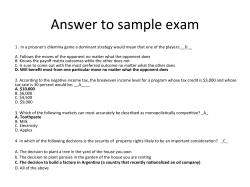
Advanced Macroeconomics II Homework Assignment #3 Krzysztof
Advanced Macroeconomics II
Homework Assignment #3
Krzysztof Makarski
Due: May 12th, 2015.
Instructions: You may and in fact you are encouraged to cooperate on your homework, provided that you acknowledge
the help and you submit your assignment in your own words. Late homework will receive 30% lower grade per each 24
hours (starting from 13:30pm). Homework should be stapled (unstapled homework will receive 5% lower grade).
1. Consider an infinite
P∞period
P endowment economy with J (J is an even number) agents with the following utility
function U (ci ) = t=0 st ∈S t β t π(st ) log cit (st ), where st = (s0 , s1 , .., st ) is an event history, S = {1, 2} is the set
of all possible events, and S t = S × S × ... × S is the setof all possible
histories. Furthermore each agent is receives
endowment according to the following formula for i ∈ 1, 2, ..., J2
1.5 if st = 1
i t
et (s ) =
0.5 if st = 2
and for i ∈
J
2
+ 1, J2 + 2, ..., J
eit (st )
=
0.5 if st = 1
1.5 if st = 2
(a) Define an Arrow-Debreu equilibrium and find it. Is it efficient, show it.
(b) Define a sequential market equilibrium with complete markets and find it. Is it efficient, show it.
(c) Define a sequential market equilibrium with incomplete markets (assume that there is a risk free asset that
pays one in all states of the world) and find it. Is it efficient, show it.
2. Consider the following hidden action model with three possible effort levels {e1 , e2 , e3 }. There are two possible
profit values πH = 10 and πL = 0. The probabilities of πH conditional on effort levels are p(πH, e1 ) = 23 ,
5
8
4
p(πH, e2 ) = 21 , and p(πH, e3 ) = 31 . The cost
√ function of effort is c1 ≡ c(e1 ) = 3 , c2 ≡ c(e2 ) = 5 , and c3 ≡ c(e3 ) = 3 .
Utility of manager is given by u(w) = w, where w denotes wage and the manager’s reservation utility u
¯ = 0.
(a) What is the optimal contract when effort is observable?
(b) Show that if effort is not observable, then e2 is not implementable. (Hint: Focus on uH and uL rather than
wages). For what levels of c2 would e2 be implementable?
(c) What is optimal contract when effort is not observable?
3. A phone company ABC monopolized the telecommunications market in the country X. It is not a usual market,
as there are only two types of customers in this market: type 1 (residential customer with low demand - low type)
and 2 (business customer with high demand). More, there is only one customer of each type. After extensive
market research the monopolist ABC estimated that demands of different types of customers are D1 (P1 ) = 5 − P1
for type 1 and D2 (P2 ) = 10 − 2P2 for type 2. Let’s assume for simplicity that cost of ABC are zero, i.e. C(Q) = 0.
Denote consumer surplus as CS(P ).
(a) Consider a monopolist that doesn’t engage in price discrimination by any means (in other words, it uses linear
pricing). What are monopolist’s profits in this case?
(b) Consider a monopolist that perfectly price discriminates. What are monopolist’s profits in this case?
(c) Consider a monopolist that wants to charge 2 different two-part tariffs: T1 (Q1 ) = f1 + P1 Q1 customized to
type 1 consumers and T2 (Q2 ) = f2 + P2 Q2 customized to type 2 customers. Formulate now the problem
of profit maximizing monopolist as CS1 (P ) − f, and by analogy a net surplus of type 2 at two part tariff
T (Q) = f + P Q as CS2 (P ) − f.
(d) At optimal solution the participation constraint for type 1 (low type) and incentive compatibility constraint
for type 2 (high type) holds with equality. The other constraints are unimportant and can be neglected at
optimal solution (check at the end). Using this info rewrite the profit maximization problem of ABC from b)
to get unconstrained problem with only P1 and P2 as decision variables. Solve first the for optimal P1 , P2 ,
and then for associated f1 , f2 and profits Π∗ .
(e) Discuss your results.
1
4. Consider a principal agent problem. The worker chooses effort e ∈ {0, 1}. Principal is risk neutral V (y−w) = y−w,
1
where y − w are her profits. Agent is risk averse u(w) − e = w 2 − e. There are two possible levels of output yH = 2
¯ = 0.
and yL = 0 with π(yH |e = 0) = 0 and π(yL |e = 1) = 0.25. The reservation utility of agent U
(a) Suppose that effort is observable. Find optimal contract.
(b) Suppose that effort is not observable. Find optimal contract.
(c) Compare your answers in (a) and (b). Discuss your results.
2
© Copyright 2025














